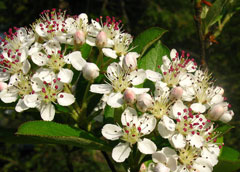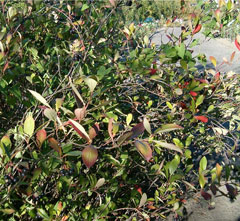 |
|
http://www.flickr.com/photos/63518505@N00 |
 |
| http://commons.wikimedia.org/wiki/User:BotBln |
Translate this page:
Summary
Bloom Color: White.
Main Bloom Time: Early spring, Late spring, Mid spring. Form: Oval.
Physical Characteristics

 Aronia arbutifolia is a deciduous Shrub growing to 3 m (9ft) by 3 m (9ft).
Aronia arbutifolia is a deciduous Shrub growing to 3 m (9ft) by 3 m (9ft).
See above for USDA hardiness. It is hardy to UK zone 4. It is in flower in May, and the seeds ripen from October to December. The species is hermaphrodite (has both male and female organs) and is pollinated by Insects.
Suitable for: light (sandy), medium (loamy) and heavy (clay) soils and prefers well-drained soil. Suitable pH: mildly acid, neutral and basic (mildly alkaline) soils. It can grow in semi-shade (light woodland) or no shade. It prefers moist soil. It can tolerate atmospheric pollution.
UK Hardiness Map
US Hardiness Map
Synonyms
Pyrus arbutifolia.
Plant Habitats
Woodland Garden Sunny Edge; Dappled Shade; Shady Edge;
Edible Uses
Edible Parts: Fruit
Edible Uses:
Fruit - raw or cooked[105]. It can also be dried and used for making pemmican[161, 183]. Fruit quality is rather variable, some forms are rather pleasant when fully ripe, especially if they have experienced some frost[2]. The fruit is about 7mm in diameter[200], it can hang on the plant for several months[235].
References More on Edible Uses
Medicinal Uses
Plants For A Future can not take any responsibility for any adverse effects from the use of plants. Always seek advice from a professional before using a plant medicinally.
None known
References More on Medicinal Uses
The Bookshop: Edible Plant Books
Our Latest books on Perennial Plants For Food Forests and Permaculture Gardens in paperback or digital formats.

Edible Tropical Plants
Food Forest Plants for Hotter Conditions: 250+ Plants For Tropical Food Forests & Permaculture Gardens.
More

Edible Temperate Plants
Plants for Your Food Forest: 500 Plants for Temperate Food Forests & Permaculture Gardens.
More

More Books
PFAF have eight books available in paperback and digital formats. Browse the shop for more information.
Shop Now
Other Uses
References More on Other Uses
Cultivation details
Landscape Uses:Border, Erosion control, Foundation, Pest tolerant, Massing, Seashore, Specimen, Woodland garden. Prefers a moist peaty soil in full sun or partial shade[134]. Succeeds in most soils[1] but dislikes shallow chalk[200]. Tolerates atmospheric pollution[227]. Plants are hardy to about -25°c[184]. This genus is closely related to Sorbus species[200]. A suckering plant, it forms thickets in the wild[182]. Some named forms have been developed for their ornamental value[182]. Plants in this genus are notably resistant to honey fungus[200]. Special Features:
Attracts birds, North American native, Wetlands plant, Attracts butterflies. The plant is heat tolerant in zones 8 through 4. (Plant Hardiness Zones show how well plants withstand cold winter temperatures.
Plant Heat Zones show when plants would start suffering from the heat.
The Plant Heat Zone map is based on the number of "heat days" experienced in a given area where the temperature climbs to over 86 degrees F (30°C).
At this temperature, many plants begin to suffer physiological damage. Heat Zones range from 1 (no heat days) to 12 (210 or more heat days).
For example Heat Zone. 11-1 indicates that the plant is heat tolerant in zones 11 through 1.) For polyculture design as well as the above-ground architecture (form - tree, shrub etc. and size shown above) information on the habit and root pattern is also useful and given here if available. The plant growth habit is multistemmed with multiple stems from the crown [1-2]. The root pattern is flat with shallow roots forming a plate near the soil surface [1-2]. The root pattern is suckering with new plants from underground runners away from the plant [1-2].
References Carbon Farming Information and Carbon Sequestration Information
Temperature Converter
Type a value in the Celsius field to convert the value to Fahrenheit:
Fahrenheit:
The PFAF Bookshop
Plants For A Future have a number of books available in paperback and digital form. Book titles include Edible Plants, Edible Perennials, Edible Trees,Edible Shrubs, Woodland Gardening, and Temperate Food Forest Plants. Our new book is Food Forest Plants For Hotter Conditions (Tropical and Sub-Tropical).
Shop Now
Plant Propagation
Seed - best sown as soon as it is ripe in pots outdoors or in a cold frame[113]. Pre-soak stored seed overnight and then cold stratify for 3 months at 2°c[113]. The seed germinates in 1 - 3 months at 15°c[134]. When large enough to handle, prick the seedlings out into individual pots and grow them on in a cold frame for their first winter. Plant out in late spring. Cuttings of half-ripe wood, July/August in a frame[113]. Division of suckers in the dormant season[200]. Very easy, they can be planted straight out into their permanent positions. Layering[200].
Other Names
If available other names are mentioned here
Native Range
NORTHERN AMERICA: Canada, Nova Scotia, Ontario, New Brunswick, Saskatchewan (south), Manitoba (south), United States, Connecticut, Indiana, Maine, Massachusetts, Michigan, New Hampshire, New Jersey, New York, Ohio, Pennsylvania, Rhode Island, Vermont, West Virginia, Illinois, Iowa, Kansas (east), Minnesota, Missouri, Nebraska (east), North Dakota (east), Oklahoma (east), South Dakota (east & southwest), Wisconsin, Montana (southeast), Alabama, Arkansas, Delaware, Florida , Georgia, Kentucky, Louisiana, Maryland, Mississippi, North Carolina, South Carolina, Tennessee, Virginia, Texas,
Weed Potential
Right plant wrong place. We are currently updating this section.
Please note that a plant may be invasive in one area but may not in your area so it's worth checking.
Conservation Status
IUCN Red List of Threatened Plants Status :

Growth: S = slow M = medium F = fast. Soil: L = light (sandy) M = medium H = heavy (clay). pH: A = acid N = neutral B = basic (alkaline). Shade: F = full shade S = semi-shade N = no shade. Moisture: D = dry M = Moist We = wet Wa = water.
Now available:
Food Forest Plants for Mediterranean Conditions
350+ Perennial Plants For Mediterranean and Drier Food Forests and Permaculture Gardens.
[Paperback and eBook]
This is the third in Plants For A Future's series of plant guides for food forests tailored to
specific climate zones. Following volumes on temperate and tropical ecosystems, this book focuses
on species suited to Mediterranean conditions—regions with hot, dry summers and cool, wet winters,
often facing the added challenge of climate change.
Read More
Expert comment
Author
(L.)Pers.
Botanical References
1143200
Links / References
For a list of references used on this page please go here
Readers comment